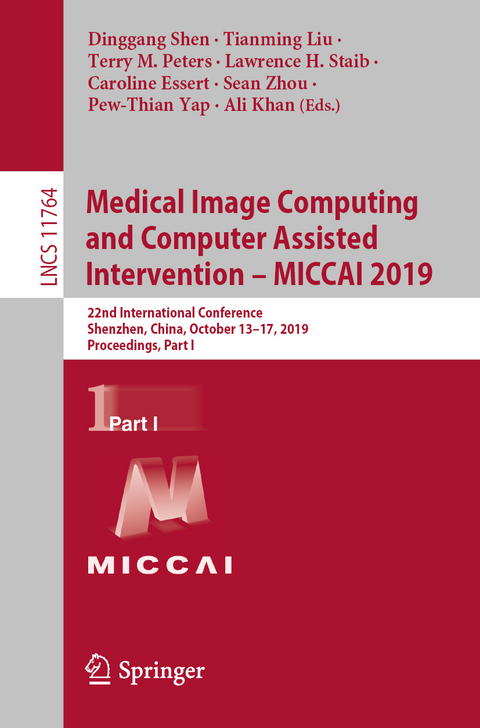
Medical Image Computing and Computer Assisted Intervention – MICCAI 2019
Springer International Publishing (Verlag)
9783030322380 (ISBN)
The six-volume set LNCS 11764, 11765, 11766, 11767, 11768, and 11769 constitutes the refereed proceedings of the 22nd International Conference on Medical Image Computing and Computer-Assisted Intervention, MICCAI 2019, held in Shenzhen, China, in October 2019.
The 539 revised full papers presented were carefully reviewed and selected from 1730 submissions in a double-blind review process. The papers are organized in the following topical sections:
Part I: optical imaging; endoscopy; microscopy.
Part II: image segmentation; image registration; cardiovascular imaging; growth, development, atrophy and progression.
Part III: neuroimage reconstruction and synthesis; neuroimage segmentation; diffusion weighted magnetic resonance imaging; functional neuroimaging (fMRI); miscellaneous neuroimaging.
Part IV: shape; prediction; detection and localization; machine learning; computer-aided diagnosis; image reconstruction and synthesis.
Part V: computer assisted interventions; MIC meets CAI.
Part VI: computed tomography; X-ray imaging.
Optical Imaging.- Enhancing OCT Signal by Fusion of GANs: Improving Statistical Power of Glaucoma Trials.- A Deep Reinforcement Learning Framework for Frame-by-frame Plaque Tracking on Intravascular Optical Coherence Tomography Image.- Multi-Index Optic Disc Quantification via MultiTask Ensemble Learning.- Retinal Abnormalities Recognition Using Regional Multitask Learning.- Unifying Structure Analysis and Surrogate-driven Function Regression for Glaucoma OCT Image Screening.- Evaluation of Retinal Image Quality Assessment Networks in Different Color-spaces.- 3D Surface-Based Geometric and Topological Quantification of Retinal Microvasculature in OCT-Angiography via Reeb Analysis.- Limited-Angle Diffuse Optical Tomography Image Reconstruction using Deep Learning.- Data-driven Enhancement of Blurry Retinal Images via Generative Adversarial Networks.- Dual Encoding U-Net for Retinal Vessel Segmentation.- A Deep Learning Design for improving Topology Coherence in Blood Vessel Segmentation.- Boundary and Entropy-driven Adversarial Learning for Fundus Image Segmentation.- Unsupervised Ensemble Strategy for Retinal Vessel Segmentation.- Fully convolutional boundary regression for retina OCT segmentation.- PM-NET: Pyramid Multi-Label Network for Optic Disc and Cup Segmentation.- Biological Age Estimated from Retinal Imaging: A Novel Biomarker of Aging.- Task Adaptive Metric Space for Medium-Shot Medical Image Classification.- Two-Stream CNN with Loose Pair Training for Multi-modal AMD Categorization.- Deep Multi Label Classification in Affine Subspaces.- Multi-scale Microaneurysms Segmentation Using Embedding Triplet Loss.- A Divide-and-Conquer Approach towards Understanding Deep Networks.- Multiclass segmentation as multitask learning for drusen segmentation in retinal optical coherence tomography.- Active Appearance Model Induced Generative Adversarial Networks for Controlled Data Augmentation.- Biomarker Localization by Combining CNN Classifier and Generative Adversarial Network.- Probabilistic Atlases to Enforce Topological Constraints.- Synapse-Aware Skeleton Generation for Neural Circuits.- Seeing Under the Cover: A Physics Guided Learning Approach for In-Bed Pose Estimation.- EDA-Net: Dense Aggregation of Deep and Shallow Information Achieves Quantitative Photoacoustic Blood Oxygenation Imaging Deep in Human Breast.- Fused Detection of Retinal Biomarkers in OCT Volumes.- Vessel-Net: Retinal Vessel Segmentation under Multi-path Supervision.- Ki-GAN: Knowledge Infusion Generative Adversarial Network for Photoacoustic Image Reconstruction in vivo.- Uncertainty guided semisupervised segmentation of retinal layers in OCT images.- Endoscopy.- Triple ANet: Adaptive Abnormal-aware Attention Network for WCE Image Classification.- Selective Feature Aggregation Network with Area-boundary Constraints for Polyp Segmentation.- Deep Sequential Mosaicking of Fetoscopic Videos.- Landmark-guided Deformable Image Registration for Supervised Autonomous Robotic Tumor Resection.- Multi-View Learning with Feature Level Fusion for Cervical Dysplasia Diagnosis.- Real-time Surface Deformation Recovery from Stereo Videos.- Microscopy.- Rectified Cross-Entropy and Upper Transition Loss for Weakly Supervised Whole Slide Image Classifier.- From Whole Slide Imaging to Microscopy: Deep Microscopy Adaptation Network for Histopathology Cancer Image Classification.- Multi-scale Cell Instance Segmentation with Keypoint Graph based Bounding Boxes.- Improving Nuclei/Gland Instance Segmentation in Histopathology Images by Full Resolution Neural Network and Spatial Constrained Loss.- Synthetic Augmentation and Feature-based Filtering for Improved Cervical Histopathology Image Classification.- Cell Tracking with Deep Learning for Cell Detection and Motion Estimation in Low-Frame-Rate.- Accelerated ML-assisted Tumor Detection in High-Resolution Histopathology Images.- Pre-operative Overall Survival Time Prediction for Glioblastoma Patients Usin
| Erscheinungsdatum | 20.10.2019 |
|---|---|
| Reihe/Serie | Image Processing, Computer Vision, Pattern Recognition, and Graphics | Lecture Notes in Computer Science |
| Zusatzinfo | XXXVII, 819 p. 345 illus., 294 illus. in color. |
| Verlagsort | Cham |
| Sprache | englisch |
| Maße | 155 x 235 mm |
| Gewicht | 1294 g |
| Themenwelt | Informatik ► Grafik / Design ► Digitale Bildverarbeitung |
| Informatik ► Theorie / Studium ► Künstliche Intelligenz / Robotik | |
| Technik | |
| Schlagworte | Applications • Artificial Intelligence • Computed tomography • Computer Aided Diagnosis • computer assisted interventions • Computer Science • conference proceedings • Image Processing • image reconstruction • Image Segmentation • Imaging Systems • Informatics • Learning Algorithms • machine learning • Medical Images • Neural networks • neuroimage reconstruction • neuroimage segmentation • Optical imaging • Research • segmentation methods • Support Vector Machines • SVM • x-ray imaging |
| ISBN-13 | 9783030322380 / 9783030322380 |
| Zustand | Neuware |
| Informationen gemäß Produktsicherheitsverordnung (GPSR) | |
| Haben Sie eine Frage zum Produkt? |
aus dem Bereich


